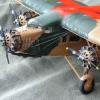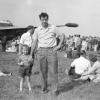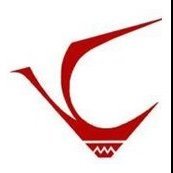Search the Community
Showing results for tags 'Ethiopia'.
-
Hi, My fourth machine of Regia Aeronautica from Italian invasion on Abyssinia in 1935-36. This is Caproni Ca. 111 C belonging to 65 Sq. RA. This was a second main derivative of Caproni high-wing colonial bomber/transport machines, next to three engine Caproni Ca 101 . The Ca 111 had single Isotta Fraschini Asso 18 cylinders W engine. It was used also as strategic recce machine due to relatively long range. More on this type here https://en.wikipedia.org/wiki/Caproni_Ca.111 The kit is Broplan "advanced vacu" (with injected small parts), very nice kit, athough not well detailed regarding undersurfaces. I started construct it within "Nothing but injected" GB, however did not manage to finish on time. Some record of work is here: Here is the result: And my shelf (the top one) with machines from Ilaian invasion on Abyssinia, from left Fiat CR 20, Caproni Ca 101, Capronie Ca 111, Romeo Ro 1 and Ethiopian Farman 192: This is mine #20 in this year, very likely this is the final score (still it is possible +1...) Comments welcome Regards Jerzy-Wojtek
-
Ethiopian-Eritrean Wars, Volume 1 Eritrean War of Independence, 1961-1988 ISBN : 9781912390298 Helion & Company via Casemate UK It would seem depressing that the area of Ethiopia and Eritrea has seen more than its fair share of conflict and misery over the years. After Italian occupation during WWII Ethiopia claimed it as part of its territory, which was cemented after the UN federated it to Ethiopia in 1950. After 9 years Haile Selassie dissolved the federation and annexed Eritrea triggering a 30 year war of independence. The main for for Eritrea in was the Eritrean Liberation Front (ELF). Thought like many such organisations the world over, infighting and internal conflict this became the Eritrean People Liberation Front (EPLF) . Even after Haile Selassie was overthrown in a coup and the region came under the influence of the Soviet Bloc the civil war continued. The EPLF had all but driven the Ethiopians out of Eritrea by 1977 when Somalia invaded Ethiopia to split their army. However massive intervention from Cuban & Yemeni forces allowed Ethiopia to regain the initiative and push back the EPLF. Soviet support ended though in at the end of the 1980s. Then the EPLF was able to join forces with other anti Marxist organisation to move against the Ethiopian Army. The US lead by former President Carter worked to end the conflict through peace talks, this lead to a peace agreement in 1989. This though did not last, however with the fall of the main Ethiopian regime in 1991 this lead to talks to establish a transitional government in Addis Ababa which the EPLF attended as an observer. In 1993 Eritrea was able to hold an Independence vote which came in at 99.83% in favour. In 1993 the UN formally admitted Eritrea as a country. The book looks at the forces on both sides of the conflict, some history of the region and how the main battles were fought. This volume is A4 soft back in format and 63 pages. There are black and white photographs throughout with maps, and 8 pages of colour profiles. Conclusion This book should provide readers with a more complete understanding of the of the conflict in Eritrea from 1961 to 1988 Recommended. Review sample courtesy of
-
Wings over Ogaden The Ethiopian-Somali War 1978-79 ISBN : 9781909982383 Helion & Company via Casemate UK In late 1977 to early 1978 Somalia launched a military offensive over the disputed Ethiopian region of Ogaden. Following a period of internal unrest in Ethiopia the Somalia leadership throught they would take advantage and take Ogaden. While a local dispute it had all the hallmarks of a cold war dispute fueld by "aid" from East & West. Somalia was originally supported by the USSR, however they were not happy with the invasion of Ethiopia and in effect switched sides to support Ethiopia. As massive airlift of supplies and 16000 Cuban troops helped save Ethiopia from defeat. On the otherside the US ceased its support of Ethiopia and started supporting Somalia. The war ended when the US brokered a ceasefire, however parts of the region would stay in Somali hands until 1980. Airpower was heavily used in the conflict with the Ethiopians having well trained pilots flying new American hardware particularly the F-5E. This new publication from Helion & Company delas with the aerial warfare in the Ethiopian - Somali War of 1978-79. The book looks at the following areas; Geopolitical Background Military Backgrounds Military Balance & Planning Invasion Switching Alliances The Rout The book is A4 softbound and 64 pages long. It is illustrated throughout with black and white photographs. In the centre are seven pages of colour aircraft profiles, five pages of colour pictures, and 4 pages of colour maps. Conclusion If you're interested in the lesser known Air Forces, and conflicts of the war this is to be recommended. Review sample courtesy of
-
Hi all, can an anyone out there confirm for me that the Sabres flown by Iran and Ethiopia (ex Iran) had the slatted short wing and not the 6-3 wing? As far as I can see from photos it was the slatted wing but various artists of profiles show the 6-3. As always, your advice is always gratefully received. Thanks. Martin
-
I've been on a bit of a go-slow with my model building recently, so I'm pleased to finally announce the arrival of Flight ET720 from Addis Ababa : This is my take on Roden's Boeing 720B kit - warts and all - but finished off with Ethiopian Airlines markings from 26Decals (Sheet 144-615). and here it is with a friend from Abidjan Thanks for looking. Time to head off back to Addis. Regards mike
- 49 replies
-
- 36
-






